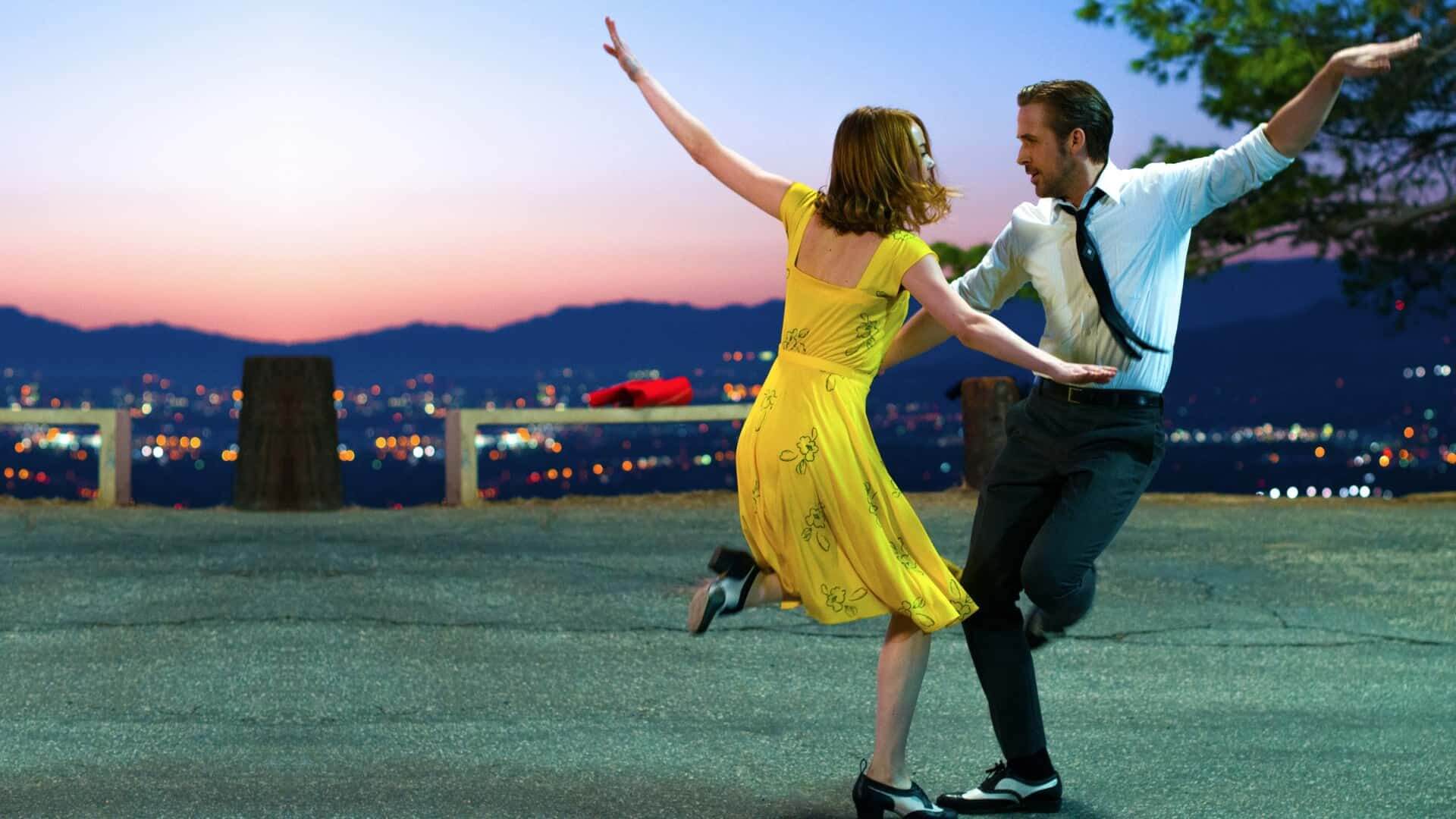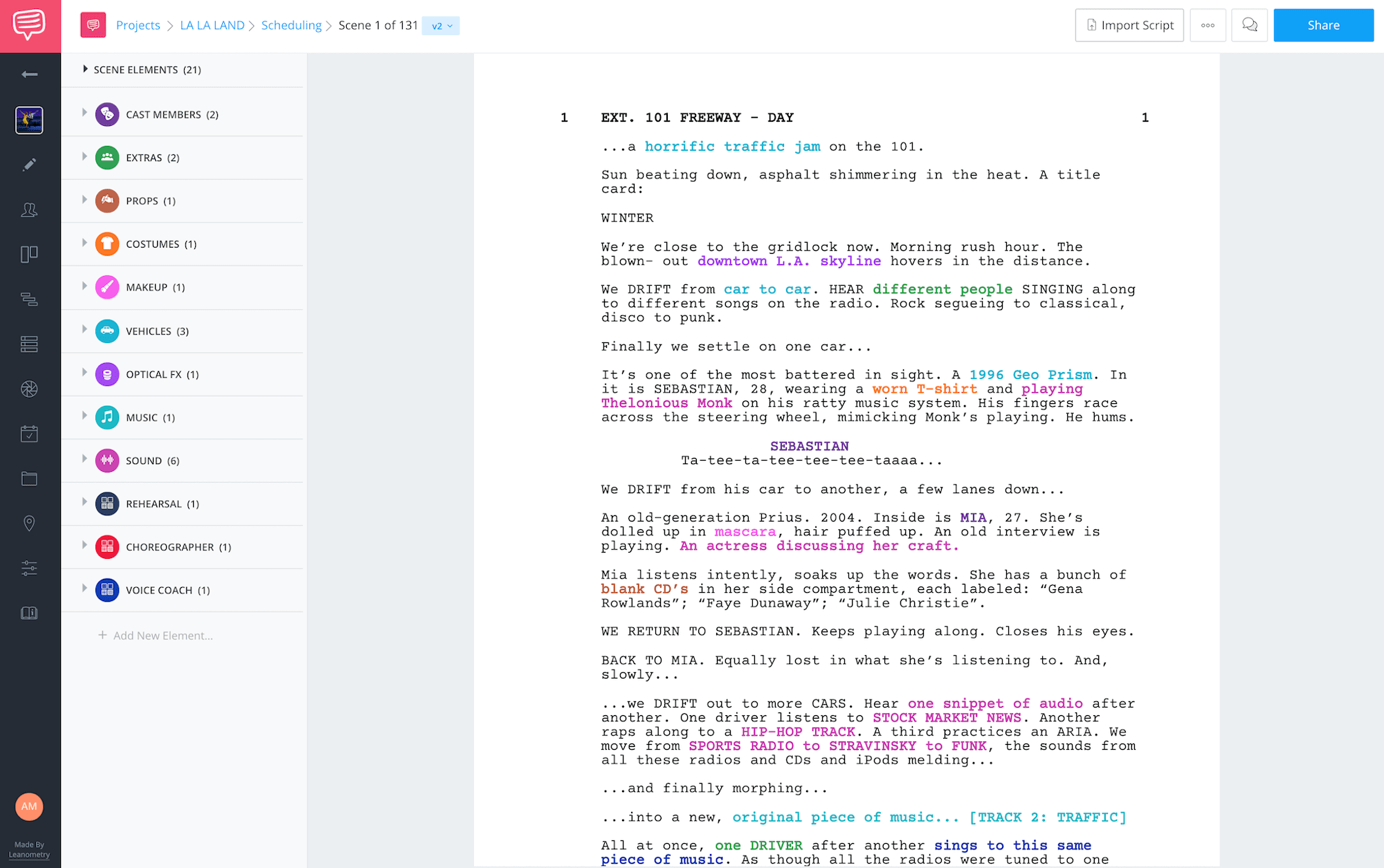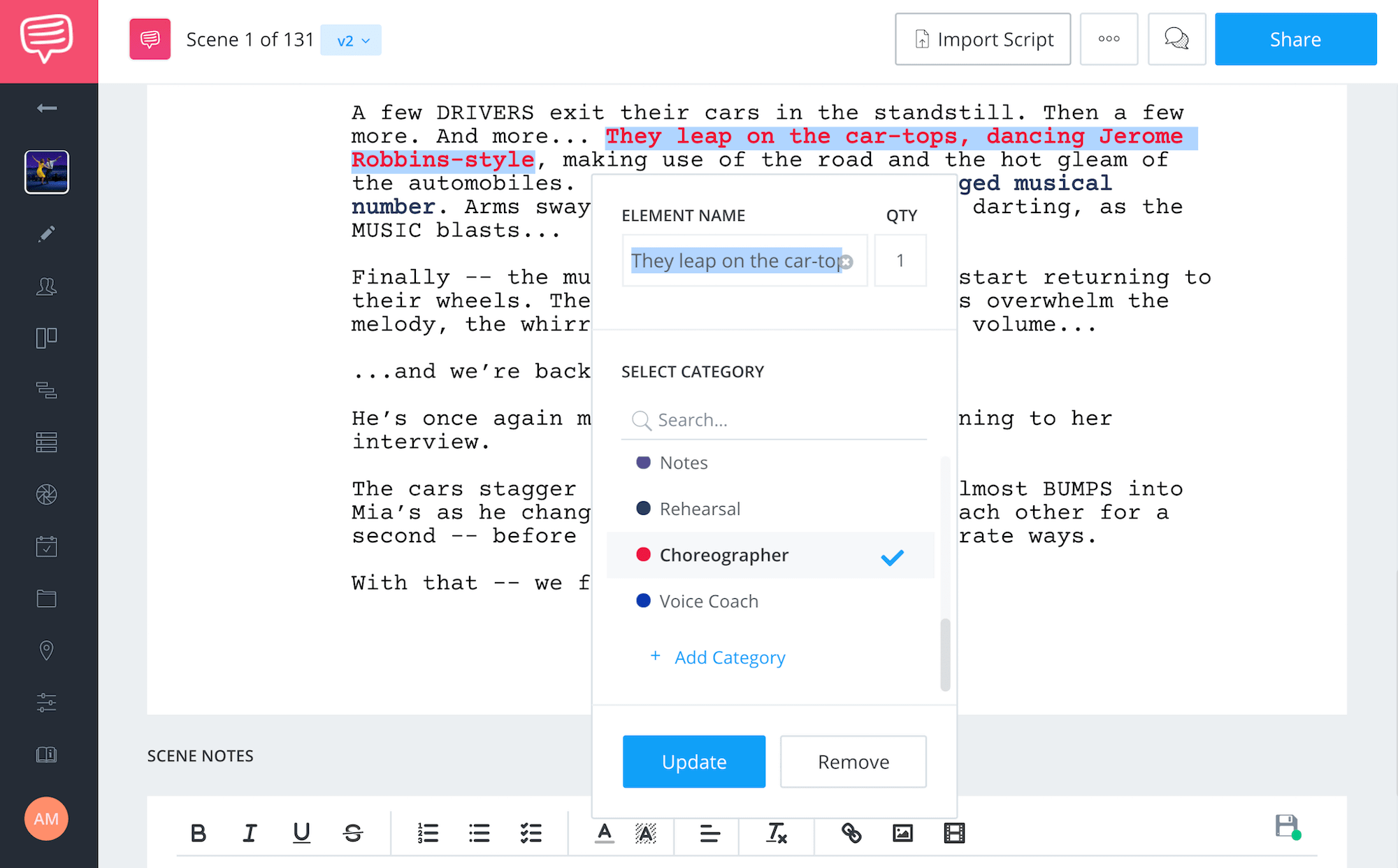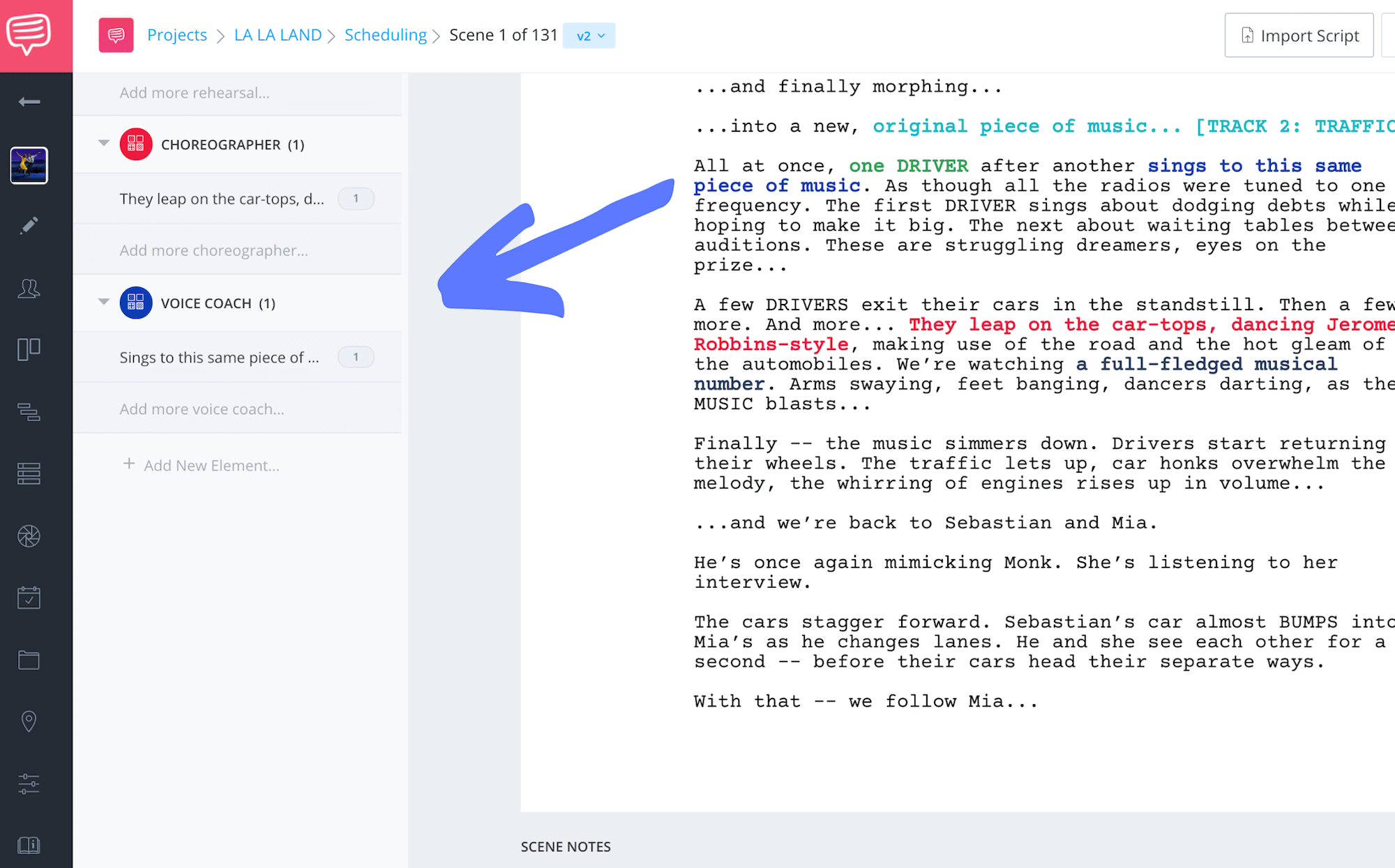Musicals are a special breed of filmmaking that requires a LOT of preparation and planning to pull off. There is singing, and dancing, and music. And it all has to be presented in the script in a particular way.
In this post we’ll look at some of the special considerations that go into making a musical using La La Land as our guide.
DIFFERING MUSICALS
1. Note musical styles
It may be helpful to know that there are two common styles of musical: the “book” musical and what is known as the “jukebox” musical.
A book musical (or “original” musical) is a production like La La Land that features original songs written specifically for the story. Take a look at the opening scene for a refresher, or if you haven't seen it.
Conventionally, book musicals have the songs included in the script (“book”). But La La Land screenwriter Damien Chazelle not only bucks this convention, he won the Oscar for Best Original Screenplay for doing it. He left out most of the lyrics in the actual script, but it still falls under a "book" musical.
Besides La La Land, other original musicals you may know are Once, The Greatest Showman, and A Star Is Born (the screenplay was adapted but the songs were all original).
The jukebox musical uses existing, usually well-known, songs that are incorporated into the story. An example of that is the riff off in any of the Pitch Perfect movies.
Sometimes the story itself is actually built around the songs, like in Mamma Mia:
But no matter what sub-genre of musical you’re making, they all require the same kind of preparation and planning.
Pre Production Tips
2. Secure licensing
Before we do anything else, we’ll need to make sure we have all the proper permission and usage rights for the songs in our musical - aka licensing - in place. While particularly applicable to a jukebox musical, even a book musical like La La Land needs to negotiate licensing terms.
Licensing musical work for a film, no matter the genre, is actually a very complicated, potentially litigious process. It’s why big-budget productions like La La Land have a whole department that handles it.
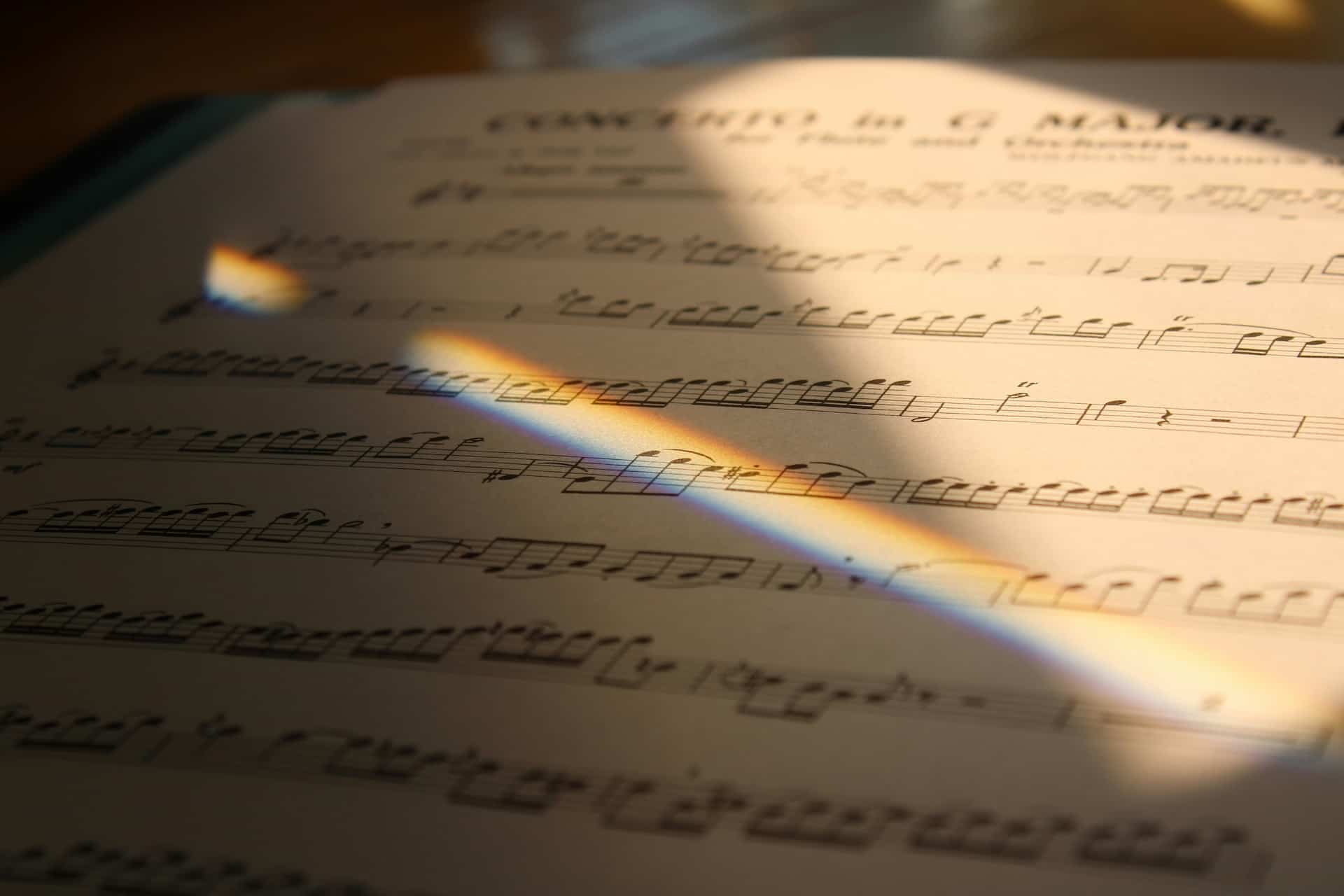
La La Land sheet music
But if you’re on a low- or micro-budget show you’re unlikely to have those kinds of resources. If that’s the case, you should always — ALWAYS — get help from the experts. The best option for super-low budgets is to include a line item for hiring a specialist attorney (or find one who will work pro bono) who can handle the licensing process.
Let me show you why...
First of all, whether a song or orchestral arrangement, musical works have two parts that need to be licensed: the publishing (or “sync”) rights, and the master rights. To use the work in our film, we need to get both.
The publisher is whoever wrote the piece. For example, even though Whitney Houston made the song “I Will Always Love You” popular in the early 1990s movie The Bodyguard, the song was actually written (and originally performed) by Dolly Parton. Dolly Parton is therefore the publisher of the song.
Sometimes there are multiple writers, like an entire band. In that case, you need permission from all of the band members.
If one of them says no, you don’t get the song.
The master rights holder is whoever recorded the work. This can be an individual producer or a record company like DefJam. If the work has never been recorded before, that makes things a bit easier for us.

You need both sync and master rights to a song
The second part of securing licensing is where it gets complicated and why you REALLY need to make sure you have experts to either handle the negotiations, or at the very least to give you crystal clear guidance.
Because we’re not just asking permission to use the songs in our film. We are actually asking for all the attendant revenue that will come from it as long as the film exists.
DID YOU KNOW?
Distributors are especially conscious of music licensing, and will frequently only negotiate a distribution deal with producers who have secured all the appropriate music rights.
There are so many ways a film — and therefore the music in it — can be distributed. Theatrical release, broadcast television, basic cable, premium cable, web-series (or “digital”), Video On Demand (VOD)/streaming, rentals, and DVD/Blu-ray for purchase. I’ve probably forgotten some as well.
Theatrical release alone can mean for film festivals only, limited release, or wide release. Each of these distribution channels has to be included in our music licensing agreement.
For example, if we don’t include premium cable in our agreement, we won’t be able to have our musical shown on HBO or Showtime.
The last part of our licensing agreement stipulates how long we have the usage rights. This where the legal phrase “in perpetuity” is often used.
What that basically means is that we have permission to use the song in our musical (or other film) forever. We’ll never have to go back and start the licensing process again.
But that’s not always the case; and it’s why legal experts are something we should try to include in our budget. Also, getting a “no” at any point in the licensing process doesn’t mean we need to stop production.
It might mean, however, that we won’t get a distribution deal until all our music rights are secured.
While our legal team is working on usage rights, and other departments are working on their own pre-production agenda, we can start working on the performances.
Related Posts
Breakdown the Scene
3. Rehearse and Record
Any production schedule should allow for a certain amount of rehearsal days for the actors. But in a musical, apart from the usual pre-production tasks, once we have our cast in place, we’ll need to get going on rehearsing all the musical numbers.
These require a choreographer. Choreographers are the people who design and teach the dance routines to the actors and other dancers.
They work with the director to make sure the routines are in line with the director’s vision, and with the cinematographer to keep the routines in the frame.
We need to make sure we include a choreographer — or choreography team — in our budget. We can determine this in the very beginning.
As a producer or first AD, you’ll be the one breaking down each scene and determining what you need. The script breakdown, as you probably already know, is just that — reading the script and tagging every scene element (prop, cast, choreographer) needed. Here is what it will look like when we begin to breakdown the opening scene:
Because it’s a musical, you’ll already know from the gate that choreographers and rehearsals will be one of the first things you call out in the breakdown.
We can highlight "They leap on the car-tops, dancing Jerome Robbins-style..." as "choreographer."
We’ll also need time in our production schedule for our performers, including musicians, to become familiar with the songs.
In fact, our actors don’t just need to learn them, we want them to sing the songs well. That means hiring a voice coach. Let’s include that in the budget too.
Breaking down your script is most beneficial to your budget, especially for a musical, which allows you to determine who needs to be hired to execute your vision.
The number of rehearsal days will vary according to what our budget allows (performers get paid for rehearsal time), but the more complicated our dance routines, the more rehearsal days we should allow. If a scene seems more challenging, you could determine that in the breakdown and write notes for the rest of your team.
Fred Astaire famously demanded six weeks of rehearsal for all the dance numbers he choreographed for himself and Ginger Rogers, but MGM could afford to meet those demands.
You might not have that kind of budget to work with.
During rehearsal time, our wardrobe department should also be working with the actors and dancers. Costumes, including shoes, will have to allow for any choreographed movements.
Costumes are another essential element that needs to be highlighted and tagged in the breakdown.
Once our cast have learned their songs, it’s time to record the playback. Playback is the pre-recorded song or music that performers will use for reference during the shoot days. The recording will also get synced up in post-production for the final film.
With rare exceptions (e.g., Tom Hooper’s Les Misérables), film musicals record all the singing before shooting begins. Singing, especially when combined with dancing, takes a lot more performance energy than you might realize.
This is especially true if you have a lot of set pieces involving lots of background dancers. Set pieces here aren’t referring to production design but rather a scene or sequence whose execution demands intensive planning.
In a musical, a “set piece” can be a break in the story — or even an introduction to the story — for a song and/or dance number.
Even if our musical doesn’t have a lot of dancing per se, we’ll still need to make sure all the performers have their movements down for each song.
The opening scene of La La Land not only took four days just to shoot, it also required weeks of preparation and planning.
The performers had to be dead on with their synchronized movements for the scene to work.

Even small scenes require rehearsals
But even a less complicated number still requires the actors to know the choreography inside and out, so their movements can look entirely organic and spontaneous.
Related Posts
Arranging the Shooting Schedule
4. Scheduling the shoot
When it comes to time to shoot our musical, we’re basically working just like we would with any other kind of narrative genre.
But there are a few things to keep in mind.
We broke down the opening scene earlier in the post and realized how involved it was. Set pieces like the opening scene are going to take up big chunks of our shooting schedule. We’ll need to build our schedule around them. But do we know how to build our schedule?
You're probably already familiar with how shooting schedules are made, but just as a refresher, let's discuss stripboards. Stripboards are where we arrange the schedule. Each strip on the board is a scene, and if you use StudioBinder's software, all of the info you just attained from the breakdown will be populated on the strips. If you want some more info on how to use a stripboard, feel free to watch the video below.
As mentioned above, the opening scene in La La Land was intricate, and involved a lot of rehearsals, extras, and even voice coaching. So it is important we work the other scenes around this big number. We can use the stripboard to do that.
We have our stripboard, our scenes are our strips. And each strip has all of the info we gathered in the breakdown, populated right onto it.
We can drag and drop the strips and arrange them in any order on our stripboard schedule.
Also, these kinds of scenes take up big chunks of our performers’ energy. We’ll need to schedule enough shoot days to make sure the dancers are fresh enough for as many takes as we need. We can add day breaks to the stripboard to space out our days. Normally, that would look something like this:
But because it's been said that La La Land's opening scene took 4 hours to shoot, our schedule would look a little different. We can add day breaks and banners to understand our schedule.
Also, sidenote, we should also have plenty of water brought to the set, especially on hot days. Dancing and acting outside in Los Angeles, can get intense. When you have all your information laid out like this, it’s easy to determine what you’ll need before you need them.
Once you’ve determined the best schedule for your cast and crew, simply run a schedule report.
You’ll have a digestible schedule ready to share or pass out to your cast and crew! If you want more scheduling tips, check out how to use the stripboard more effectively to create the most efficient shooting schedule possible, no matter what genre you’re tackling.
Related Posts
Up Next
Create the most effective schedule
You now have a little more insight on what it takes to schedule a musical. But maybe you’re a little foggy on all the technical aspects of scheduling.
No worries. We have you covered. Knowing about these particular considerations is the hardest part. Let it inform how you use the stripboard. The next post dives deeper into using the stripboard to create the most efficient and organized shooting schedule you’ve made yet.
